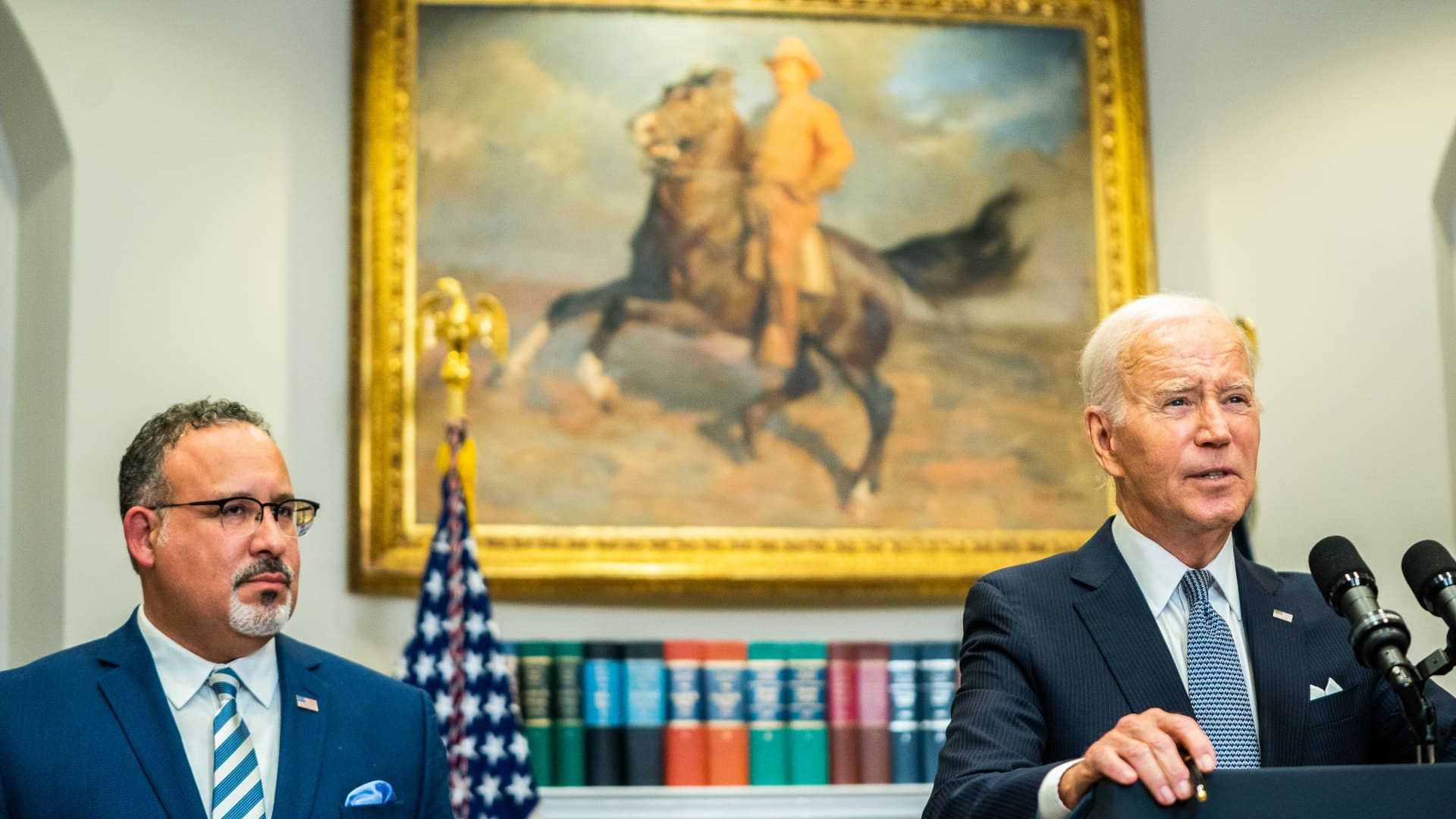Products You May Like
The Biden administration Friday said it would forgive $39 billion of student debt for 804,000 borrowers, many of whom may be wondering if the action will meet the same doom as the forgiveness plan killed by the Supreme Court last month.
Student loan experts think this one is likely to survive.
“Undoubtedly you’ll see some legal complaints,” said Mark Kantrowitz, a higher education expert. “But they won’t go anywhere.”
More from Personal Finance:
As student loan payments restart, can employers be a firewall?
2 big takeaways from Supreme Court ruling on student loan forgiveness
Student loan repayment is about to change in a big way
“I think anybody who gets this [forgiveness] can be assured it’s going to stay,” he added.
How are the two loan forgiveness actions different?
The latest action isn’t the same as the broad debt-cancellation plan originally sought by the White House, which Supreme Court justices struck down in a 6-3 decision on June 30. That action would have erased up to $20,000 of student debt for tens of millions of borrowers carrying federal loans. It had an estimated cost of $400 billion.
Friday’s announcement concerns borrowers in income-driven repayment plans. There are four of these plans, which aim to make loan payments more affordable for lower earners.
IDR plans cap monthly payments, generally at 10% or 20% of a household’s discretionary income, depending on the plan. The U.S. Department of Education is trying to enact a new plan with a 5% cap.
Importantly, borrowers who make regular payments — generally for 20 or 25 years — get their remaining loan balances erased at that time.
However, the Biden administration said that forgiveness hasn’t occurred in many cases — even though borrowers had earned it — due to administrative errors.
Beneficiaries of the new policy will see their debt automatically discharged in coming weeks, the Department of Education said.
“For far too long, borrowers fell through the cracks of a broken system that failed to keep accurate track of their progress towards forgiveness,” U.S. Secretary of Education Miguel Cardona said in a statement announcing the action.
The recent plan has a different legal precedent
Some lawmakers issued statements last week questioning the newest forgiveness action’s legal footing.
For example, Rep. Virginia Foxx, R-N.C., chair of the House Committee on Education and the Workforce, said the Biden administration was “trampling the rule of law” and attempting to “circumvent” the Supreme Court’s recent ruling on loan forgiveness.
Yet, the two actions are grounded in different legal precedents, experts said.
“The two programs have nothing to do with one another,” said attorney Abby Shafroth, co-director of advocacy and director of the student loan borrower assistance program at the National Consumer Law Center.
The sweeping — and now-defunct — forgiveness plan President Joe Biden announced in August 2022 rested on the Heroes Act of 2003. That law gave the president power to revise student loan programs during national emergencies.
This program is narrowly tailored to people who’ve been in repayment for decades already.Abby Shafrothco-director of advocacy and director of the student loan borrower assistance program at the National Consumer Law Center
The White House argued the Covid-19 pandemic was one such emergency. The Trump administration had leveraged the Heroes Act to implement a student loan payment pause at the onset of the Covid-19 pandemic. That pause persists today but will end in the fall.
The Supreme Court disagreed with the Biden administration. The Department of Education needs authorization from Congress to cancel such a large amount of consumer debt, justices said.
However, Congress has already authorized loan forgiveness relative to income-driven repayment plans, dating to when it created them in the 1990s.
“This program is narrowly tailored to people who’ve been in repayment for decades already,” Shafroth said. “It all goes back years and is really about proper implementation of a program Congress established in 1995.”
The plan is on “really sound legal footing,” she added. In fact, the Department of Education was almost legally compelled to fix its past errors or open itself up to lawsuits from borrowers, she said.
Beneficiaries of the new policy are predominantly those who are or once were in the Income-Contingent Repayment program, the only one of the four IDR plans that has existed long enough to deliver debt forgiveness, Kantrowitz said. The average borrower in that program has a loan balance of $48,000, he said.
IDR forgiveness roots predate a Supreme Court ruling
That said, the Biden administration had some leeway when deciding on the scope of forgiveness, Kantrowitz said.
Largely, that leeway concerned whether certain loan payments should or shouldn’t count toward a borrower’s overall payment tally, and ultimately, whether they have or haven’t satisfied the criteria for loan forgiveness (i.e., by making two decades of regular payments).
The Department of Education looked at three broad areas in this regard: economic hardship deferments, loan forbearance and partial or late payments, Kantrowitz said. Here, it appears “well within” the Department of Education’s discretion to decide which payments count and which don’t, he said.
“The court is likely to give great deference to the federal agencies on those matters,” he said.
The Department of Education said last year that it would be undergoing a review of all IDR enrollees and make a one-time adjustment to their accounts. The latest action is the result of that review, which was announced in April 2022, before Biden unveiled his sweeping plan in August 2022 to forgive up to $20,000 for all borrowers.
In other words, the roots of Friday’s announcement to forgive $39 billion of debt predate both the Supreme Court ruling and the original policy announcement on which the court ruled, experts said.
Additionally, questions over legality are largely moot anyway for borrowers who get relief before any sort of lawsuit arrives, Kantrowitz said. “The court wont claw back [your] forgiveness.”
